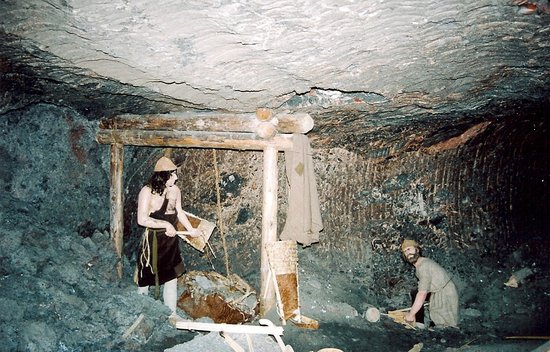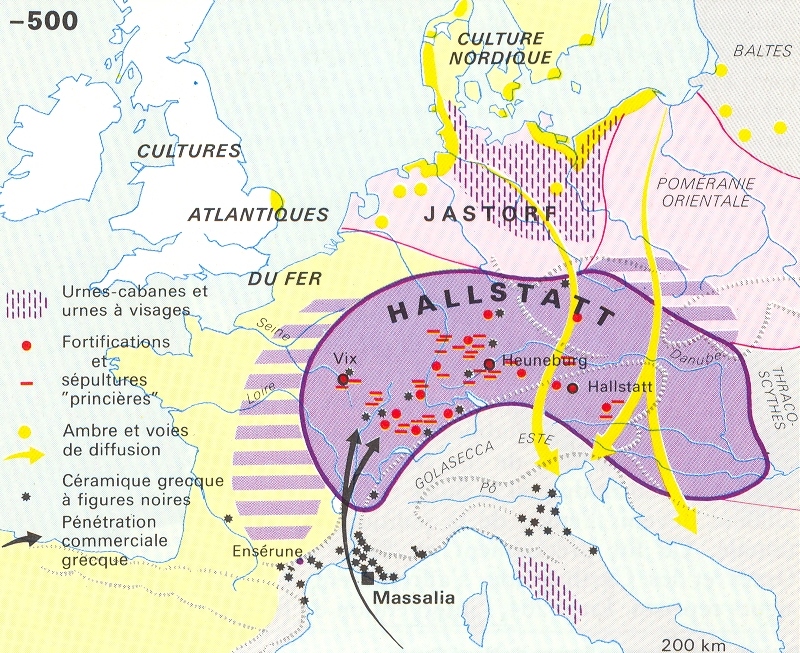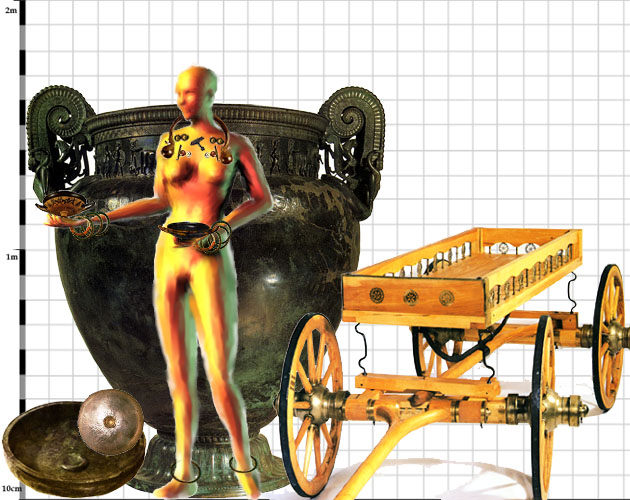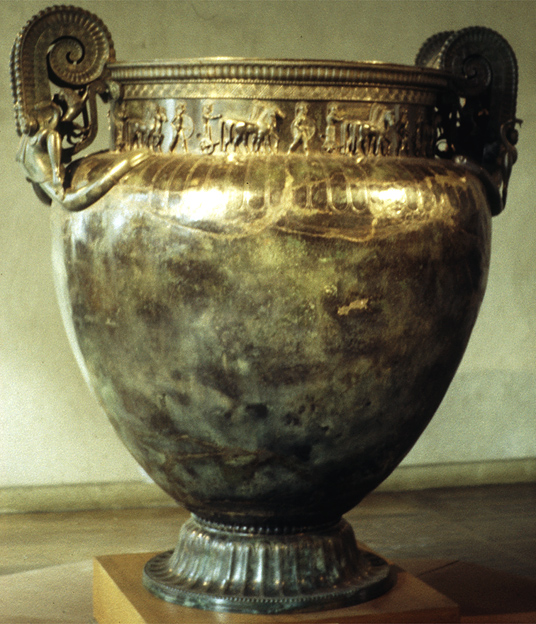Who Was the Mysterious Lady of Vix?
Until recently, the only Vix I knew about was the stock market’s Volatility Index (abbreviated VIX). If there were a volatility index for cryptocurrencies, I’d surely invest in it. And then there’s that cold medicine called Vicks. I caught a seasonal cold a couple of days ago, and my sinus headache felt like a hangover (though I didn’t drink) on New Year’s Eve. So I skipped the festivities and made an early night of it, waking up to 2018 when my dog needed to go outside in the early morning hours.
It turns out there is another Vix, which I learned by viewing a documentary film last week about early Celtic burial sites in Europe. The Celts were somewhat mysterious, since their origins are not well known. Many people think of the Celts as largely having inhabited Ireland, Scotland, and Britain, where the language and cultural roots remained strong. But the early Celts were based much further south. Some historians even believe that those who reached the British Isles were a different people altogether.
Celtic grave sites from the 5th or 6th century indicate the culture was focused in modern day France, Germany, Switzerland, and Austria. These were the Hallstatt Celts, named for an extensive burial site located in Hallstatt, Austria, near the city of Salzburg. This site was located near a valuable salt mine and it dated back even earlier than many others. Over time, they spread to other regions of Western, Central, and Eastern Europe.

Hallstatt Salt Mine with depiction of early miners. Source link below.
Who Were the Original Celts?
Burial sites make it clear that the early Celtic culture had a strong Mediterranean orientation. Their most important people were buried with extensive riches, many of which were Greek or Italian in origin. It is not known whether they came from the Mediterranean region originally or simply traded heavily with the high cultures to the south. But the Greeks also provide the first written record of the Celts (which is important, since the Celts left no written records of their own).
The Greek historian Herodotus, who lived in the 5th century B.C., provided the first historical mention of the Celts. Herodotus was quite amazing himself, since he was the first Greek writer who ever mentioned anything beyond the Mediterranean region. He was known to have been born in the Persian Empire (in modern day Turkey) and he travelled extensively in the Mediterranean and Black Sea regions, chronicling many of the stories he heard.

The Greek historian Herodotus. Creative Commons via Wikimedia by Marie-Lan Nguyen.
Some were more believable than others, but many of his details have fit with other historical evidence. Like other writers of the time, Herodotus shared his historical chronicles by reading them in public. To great fanfare, he travelled to the Olympic Games and read his entire Histories to the crowd there.
Herodotus gave us the name Celts, which is used today. He described the people as living on the upper reaches of the Danube River. (He also said they dwelled beyond the “pillars of Hercules”, though that may have been one way to say they were not in the Mediterranean sphere. There were Celtic sites in Spain as well, beyond the Straits of Gibraltar that are generally believed to have been the pillars.)
If he traveled in the Black Sea region, then Herodotus may have seen the Danube River himself, since it empties into the sea there. He also would have come into contact with traders who voyaged further up the river. The Danube begins in the Black Forest in southern Germany and today it touches no less than 10 countries on its way to the Black Sea. From the Black Forest to the Black Sea, is one of the world’s longest rivers.

Map of the Hallstatt Celt culture. HistoryGuru.com.au.
An important Celtic site was unearthed at Heuneburg, in southern Germany, which sits near the banks of the upper Danube. It would have been a hugely important trading site and there is archaeological evidence that thousands of people may have lived at the Heuneberg citadel. The location on the upper Danube seems to be a perfect match for Herodotus’ account.
The Lady of Vix and Her Treasures
At early Celtic sites around Europe, very important people were buried with an impressive amount of their wealth. It is probably no accident that many such sites were located on major rivers, where the Celts would have been in a position to profit from these trade routes. This is certainly true of Vix, in northern Burgundy, France. Vix was the site of a large Celtic complex, centered on Mont Lassois, which could have controlled trade on the Seine River during its heyday in the 5th and 6th centuries B.C.

Mont Lassois, the flat hill topped by the Vix complex, set in a perfect position to control trade on the river. http://artehis.u-bourgogne.fr/.
A large palace building was excavated at the Vix site, its design resembling the architecture of early Greek halls. A big quantity of expensive and imported materials was found all over the complex, suggesting plenty of wealth and trade. In about 500 B.C., a woman of great importance was buried nearby.
The Lady of Vix has sometimes been called the Queen, Princess, or Priestess of Vix. Her identity is something of a mystery, but she was treated with extreme reverence. The Lady of Vix was buried with a chariot (cart) and a large amount of jewelry, including a 24-karat gold torc of 480 grams, a bronze torc, six fibulae, six slate bracelets, a bracelet of amber, and Etruscan rings. Nearby was a necklace of amber that probably belonged to her also.


Lady of Vix and her possessions. Source: Realms-of-gold.com; Gold torque from Vix. Creative Commons via Flickr by Rosemania.
Her jewelry included items of both amber and coral. Amber, the fossilized tree resin which is highly prized, came from the Baltic region of northern Europe. The white coral in her jewelry would have come from the Mediterranean. These two items alone, found in modern-day Burgundy, are testament to a robust trading network at the time which must have stretched thorough Europe in almost every direction.
The Giant Krater
Herodotus also told of a giant bronze krater (a decorated pot often used for winemaking), made by the bronze smiths of Sparta and destined for a Lydian king (in modern day Turkey). He wrote that it was so big that it could hold 300 amphora of wine (about 300 gallons). But throughout history, there had never been any discovery that came close to this size. Historians laughed at the claim as a tall tale from Herodotus, since Greek kraters tended to be much smaller.
Then in 1953, a French archaeologist began scraping away mud from an object at the Vix grave that turned out to be a carved Gorgon with her tongue sticking out. It was a decoration on an immense Greek object, the likes of which no one had ever seen before. The object was a huge krater.


*
Krater of Vix and its detail work. Top: Creative Commons via Wikimedia by Peter Northover. Middle: Creative Commons via Wikimedia by Wikirigaou. Bottom: Nationalgeographic.com.
The bronze pot measured 5 feet 4 inches tall (1.63 meters) and weighed 450 pounds (200 kg). At 1100 liters, its capacity was almost exactly the 300 amphora (300 gallons) that Herodotus had described. This is the largest bronze vessel ever found from the western Classical period. And of all the possible kings and courts and rich merchants of the ancient world around the high culture of Greece, this krater was found thousands of miles/kilometers from the ‘known’ ancient world of the time.
It was buried in the tomb of the Lady of Vix.
Sources:
Enigma of the Celtic Tomb (video): https://www.amazon.com/Enigma-Celtic-Tomb-Alexis-Favitski/dp/B075H6RGV1
Herodotus: http://www.history.com/topics/ancient-history/herodotus
More on Herodotus: https://en.wikipedia.org/wiki/Herodotus
Heuneberg Celtic Site: https://en.wikipedia.org/wiki/Heuneburg
Vix Grave: https://en.wikipedia.org/wiki/Vix_Grave
The Huge Greek Krater at Vix: http://www.nytimes.com/1984/04/01/travel/a-greek-treasure-in-france.html?pagewanted=all
Musee du Chatillonais: https://www.burgundytoday.com/historic-places/museums/musee-du-chatillonnais.htm
Salt Mine Picture: https://www.tripadvisor.com/LocationPhotoDirectLink-g190427-d607563-i17172875-Salz_Welten-Hallstatt_Upper_Austria.html#17172875
Top image: www.geo.de


That was a very good read @donkeypong. Learned quite a bit about the Celts and Lady of Vix by reading your post.
It is common in most high cultures to bury their persons of status and renown with beautiful jewelry and other art pieces or weapons of war.
From the Pharaohs of old Egypt to the Scythian, Celtic burial mounds, most cultures shared similar burial customs.
That was a definitely harmonious admittance @donkeypong. Learned quite a bit roughly the Celts and Lady of Vix by reading your tallying.
It is common in most high cultures to bury their persons of status and renown when beautiful jewelry and accumulation art pieces or weapons of feat.
From the Pharaohs of dated-fashioned Egypt to the Scythian, Celtic burial mounds, most cultures shared same burial customs.
right man.
Haha, it my first glance, I think you are talking about the history of the vix index in stock market.
This is so interesting. I really would like to know the name of this mysterious "Lady of Vix" with so much wealth. But how come her name is not known? That wine cup is massive. The jewelries will pass for very expensive antiques.
Something that amazes me in history though, they seems to be in so much wealth then. Compare to now, do we still have such wealth, that could major for the wealth and riches in record of history back then?
We still do have such wealth but you have to look to the 1% for that. (or 0.01% more specifically)
The income disparity is really a serious issue.
So many questions and we may never know the answers.
First of all, get past your illness .. I'm sorry for you. I also learned about the celts that men understood that they were going to be prisoners and that when they killed their women, they belonged to the tribe. Whatever this is, my thoughts are reversed. I did not love them :)
Unique history and images. There is so much to learn around the world
Yes it is. He understands how to write good contents.
Karma may be a bitch, but Lady Vix is a Super Bitch!
I think, the meaning of the lady of vix statue biting her tongue, indicating she wanted to lock her secret.
interesting to review.
I'm at university for archaeology (paleolithic), and one of my TAs is a celtic archaeology P.HD student. She and I were just talking about this! Thanks for the great post--always love to see archaeology on Steem :)
Amazing. You probably know far more about it than I do! :)
I doubt that! My focus is in the overlap between modern humans, Denisovans, and Neanderthals, specifically in their fire and stone tool technologies and their varying propensities for creating material culture. I love Celtic archaeology, but the preservation of organic material in that part of the world is astoundingly bad because of the moisture, so a lot of the stuff I study never had a chance of surviving.
That's fascinating stuff. Perhaps you'll write more about it on your blog.
I'd love to! Unfortunately, most of my research is ongoing and still unpublished, so the stuff I'm directly involved in will need to wait. However, I could probably regurgitate some of my class papers on here. I have a recent one on the evolution of meat-eating in hominins...
A wonderful read. This brings up many questions both archaeological and historical in nature. I think of how much that Krater weighed. Like the pyramids of their day, I wonder if a Goliath or two were responsible for pacing this jewel there as it was over sized. It is intriguing to draw comparisons of these mystery cultures Celts, Egyptians, Mayans etc. How did these things happen. Normal humans are not that strong or able. I go back to another people - Goliath's, Fallen Angels, Hybrids of entities, Genesis 6, Enoch. Etc. Thanks for sharing.
Aren't the Celtics these guys with Kyrie Irving?
That the Hoops branch of Celts, circa 2018 A.D.
Hay donkeypong. My name is ubay. I have read your post. I think when we are dead. We do not need to bring our treasure to our cemetery. Better we give onother person who need money. But that is our past. So i think we dont need to do it again like that lady VIX. Thank you
It was a different belief system some of these cultures had. Today, most of us believe 'you can't take it with you' (your possessions).
Yea thank you donkeypong. btw nice posting. Now i can open my mind with thia different cultures.